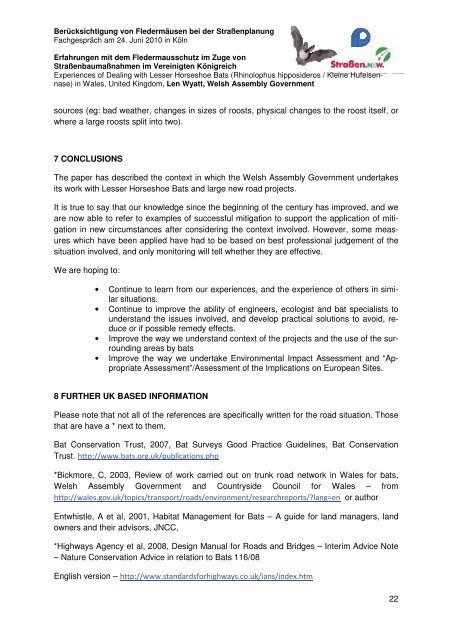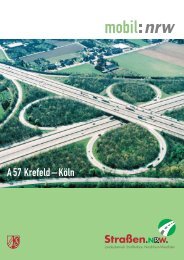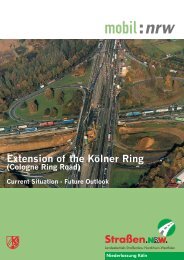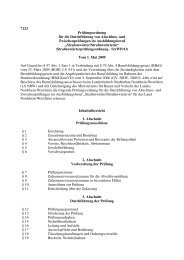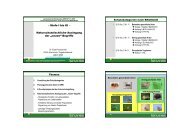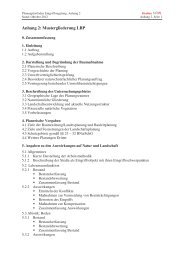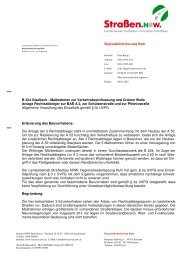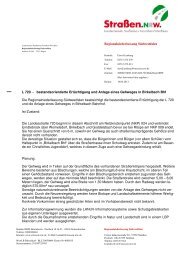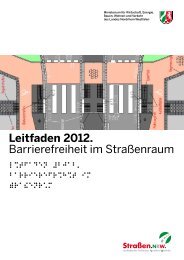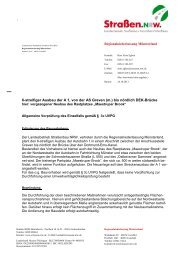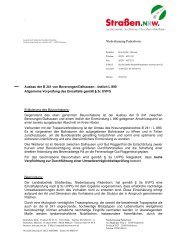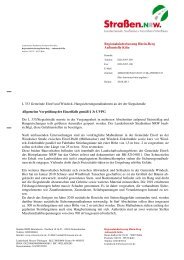1 1 INTRODUCTION This paper has been prepared to support a ...
1 1 INTRODUCTION This paper has been prepared to support a ...
1 1 INTRODUCTION This paper has been prepared to support a ...
You also want an ePaper? Increase the reach of your titles
YUMPU automatically turns print PDFs into web optimized ePapers that Google loves.
Berücksichtigung von Fledermäusen bei der Straßenplanung<br />
Fachgespräch am 24. Juni 2010 in Köln<br />
Erfahrungen mit dem Fledermausschutz im Zuge von<br />
Straßenbaumaßnahmen im Vereinigten Königreich<br />
Experiences of Dealing with Lesser Horseshoe Bats (Rhinolophus hipposideros / Kleine Hufeisennase)<br />
in Wales, United Kingdom, Len Wyatt, Welsh Assembly Government<br />
sources (eg: bad weather, changes in sizes of roosts, physical changes <strong>to</strong> the roost itself, or<br />
where a large roosts split in<strong>to</strong> two).<br />
7 CONCLUSIONS<br />
The <strong>paper</strong> <strong>has</strong> described the context in which the Welsh Assembly Government undertakes<br />
its work with Lesser Horseshoe Bats and large new road projects.<br />
It is true <strong>to</strong> say that our knowledge since the beginning of the century <strong>has</strong> improved, and we<br />
are now able <strong>to</strong> refer <strong>to</strong> examples of successful mitigation <strong>to</strong> <strong>support</strong> the application of mitigation<br />
in new circumstances after considering the context involved. However, some measures<br />
which have <strong>been</strong> applied have had <strong>to</strong> be based on best professional judgement of the<br />
situation involved, and only moni<strong>to</strong>ring will tell whether they are effective.<br />
We are hoping <strong>to</strong>:<br />
• Continue <strong>to</strong> learn from our experiences, and the experience of others in similar<br />
situations.<br />
• Continue <strong>to</strong> improve the ability of engineers, ecologist and bat specialists <strong>to</strong><br />
understand the issues involved, and develop practical solutions <strong>to</strong> avoid, reduce<br />
or if possible remedy effects.<br />
• Improve the way we understand context of the projects and the use of the surrounding<br />
areas by bats<br />
• Improve the way we undertake Environmental Impact Assessment and “Appropriate<br />
Assessment”/Assessment of the Implications on European Sites.<br />
8 FURTHER UK BASED INFORMATION<br />
Please note that not all of the references are specifically written for the road situation. Those<br />
that are have a * next <strong>to</strong> them.<br />
Bat Conservation Trust, 2007, Bat Surveys Good Practice Guidelines, Bat Conservation<br />
Trust. <br />
*Bickmore, C, 2003, Review of work carried out on trunk road network in Wales for bats,<br />
Welsh Assembly Government and Countryside Council for Wales – from<br />
or author<br />
Entwhistle, A et al, 2001, Habitat Management for Bats – A guide for land managers, land<br />
owners and their advisors, JNCC,<br />
*Highways Agency et al, 2008, Design Manual for Roads and Bridges – Interim Advice Note<br />
– Nature Conservation Advice in relation <strong>to</strong> Bats 116/08<br />
English version – <br />
22


